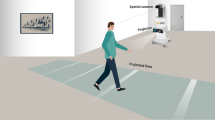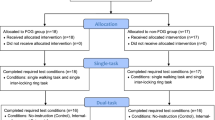Abstract
Cueing or feedback provided when gait deviates from a predefined goal (intelligent input) can now be provided with wearable technology for Parkinson’s disease (PD). As people with and without freezing of gait (FOG) have distinct cognitive profiles, they may respond differently to various types of input. This study compared the effects of four input modalities during prolonged walking and explored the relationship with cognition, subjective preference, and FOG. Participants (15 with and 13 without FOG) walked 30 min while exposed to continuous cueing; intelligent cueing; intelligent feedback; or no input. Cueing consisted of metronome beats matched to comfortable cadence. Intelligent input represented bouts of ten beats indicating comfortable cadence (intelligent cueing) or an instruction to adapt gait speed (intelligent feedback) when cadence deviated from the comfortable target. Preference for one condition over the other was gathered. Freezers produced most stable gait under continuous cueing, but the majority favored intelligent feedback. Non-freezers showed no differences between conditions, but gait was more stable under intelligent input than in freezers. Interestingly, lower cognitive scores were related to worse gait during intelligent input, most prominently seen in freezers. These results suggest that cognitive ability is an aspect to take into account when deciding on the most appropriate cueing modality in different PD subgroups.




Similar content being viewed by others
References
Amboni M, Stocchi F, Abbruzzese G, Morgante L, Onofrj M, Ruggieri S, Tinazzi M, Zappia M, Attar M, Colombo D, Simoni L, Ori A, Barone P, Antonini A, DS Group (2015) Prevalence and associated features of self-reported freezing of gait in Parkinson disease: the DEEP FOG study. Parkinsonism Relat Disord 21(6):644–649. doi:10.1016/j.parkreldis.2015.03.028
Nutt JG, Bloem BR, Giladi N, Hallett M, Horak FB, Nieuwboer A (2011) Freezing of gait: moving forward on a mysterious clinical phenomenon. Lancet Neurol 10(8):734–744. doi:10.1016/S1474-4422(11)70143-0
Heremans E, Nieuwboer A, Vercruysse S (2013) Freezing of gait in Parkinson’s disease: where are we now? Curr Neurol Neurosci Rep 13(6):350. doi:10.1007/s11910-013-0350-7
Vandenbossche J, Deroost N, Soetens E, Coomans D, Spildooren J, Vercruysse S, Nieuwboer A, Kerckhofs E (2012) Freezing of gait in Parkinson’s disease: disturbances in automaticity and control. Front Hum Neurosci 6:356. doi:10.3389/fnhum.2012.00356
Nieuwboer A, Feys P, de Weerdt W, Dom R (1997) Is using a cue the clue to the treatment of freezing in Parkinson’s disease? Physiother Res Int 2(3):125–132 (discussion 133–124)
Rocha PA, Porfirio GM, Ferraz HB, Trevisani VF (2014) Effects of external cues on gait parameters of Parkinson’s disease patients: a systematic review. Clin Neurol Neurosurg 124:127–134. doi:10.1016/j.clineuro.2014.06.026
Nonnekes J, Snijders AH, Nutt JG, Deuschl G, Giladi N, Bloem BR (2015) Freezing of gait: a practical approach to management. Lancet Neurol 14(7):768–778. doi:10.1016/S1474-4422(15)00041-1
Vercruysse S, Spildooren J, Heremans E, Vandenbossche J, Wenderoth N, Swinnen SP, Vandenberghe W, Nieuwboer A (2012) Abnormalities and cue dependence of rhythmical upper-limb movements in Parkinson patients with freezing of gait. Neurorehabil Neural Repair 26(6):636–645. doi:10.1177/1545968311431964
Spildooren J, Vercruysse S, Meyns P, Vandenbossche J, Heremans E, Desloovere K, Vandenberghe W, Nieuwboer A (2012) Turning and unilateral cueing in Parkinson’s disease patients with and without freezing of gait. Neuroscience 207:298–306. doi:10.1016/j.neuroscience.2012.01.024
Tolleson CM, Dobolyi DG, Roman OC, Kanoff K, Barton S, Wylie SA, Kubovy M, Claassen DO (2015) Dysrhythmia of timed movements in Parkinson’s disease and freezing of gait. Brain Res 1624:222–231. doi:10.1016/j.brainres.2015.07.041
Peterson DS, Smulders K (2015) Cues and attention in parkinsonian gait: potential mechanisms and future directions. Front Neurol 6:255. doi:10.3389/fneur.2015.00255
Bachlin M, Plotnik M, Roggen D, Giladi N, Hausdorff JM, Troster G (2010) A wearable system to assist walking of Parkinson s disease patients. Methods Inf Med 49(1):88–95. doi:10.3414/ME09-02-0003
Espay AJ, Baram Y, Dwivedi AK, Shukla R, Gartner M, Gaines L, Duker AP, Revilla FJ (2010) At-home training with closed-loop augmented-reality cueing device for improving gait in patients with Parkinson disease. J Rehabil Res Dev 47(6):573–581
Hove MJ, Suzuki K, Uchitomi H, Orimo S, Miyake Y (2012) Interactive rhythmic auditory stimulation reinstates natural 1/f timing in gait of Parkinson’s patients. PLoS One 7(3):e32600. doi:10.1371/journal.pone.0032600
Zhao Y, Nonnekes J, Storcken EJ, Janssen S, van Wegen EE, Bloem BR, Dorresteijn LD, van Vugt JP, Heida T, van Wezel RJ (2016) Feasibility of external rhythmic cueing with the Google Glass for improving gait in people with Parkinson’s disease. J Neurol 263(6):1156–1165. doi:10.1007/s00415-016-8115-2
Ferraye MU, Fraix V, Pollak P, Bloem BR, Debu B (2016) The laser-shoe: a new form of continuous ambulatory cueing for patients with Parkinson’s disease. Parkinsonism Relat Disord 29:127–128. doi:10.1016/j.parkreldis.2016.05.004
Ginis P, Nieuwboer A, Dorfman M, Ferrari A, Gazit E, Canning CG, Rocchi L, Chiari L, Hausdorff JM, Mirelman A (2016) Feasibility and effects of home-based smartphone-delivered automated feedback training for gait in people with Parkinson’s disease: a pilot randomized controlled trial. Parkinsonism Relat Disord 22:28–34. doi:10.1016/j.parkreldis.2015.11.004
Baram Y, Aharon-Peretz J, Badarny S, Susel Z, Schlesinger I (2016) Closed-loop auditory feedback for the improvement of gait in patients with Parkinson’s disease. J Neurol Sci 363:104–106. doi:10.1016/j.jns.2016.02.021
Ginis P, Heremans E, Ferrari A, Dockx K, Canning CG, Nieuwboer A (2017) Prolonged walking with a wearable system providing intelligent auditory input in people with Parkinson’s disease. Front Neurol 8:128. doi:10.3389/fneur.2017.00128
Keus SH, Munneke M, Graziano M, Paltamaa J, Pelosin E, Domingos J, Brühlmann S, Ramaswamy B, Prins J, Struiksma C, Rochester L, Nieuwboer A, Bloem BR (2014) European Physiotherapy Guideline for Parkinson’s disease. https://parkinsonnet.typeform.com/to/nX4O6E. Accessed 10 Apr 2017
Willems AM, Nieuwboer A, Chavret F, Desloovere K, Dom R, Rochester L, Jones D, Kwakkel G, Van Wegen E (2006) The use of rhythmic auditory cues to influence gait in patients with Parkinson’s disease, the differential effect for freezers and non-freezers, an explorative study. Disabil Rehabil 28(11):721–728. doi:10.1080/09638280500386569
Arias P, Cudeiro J (2010) Effect of rhythmic auditory stimulation on gait in Parkinsonian patients with and without freezing of gait. PLoS One 5(3):e9675. doi:10.1371/journal.pone.0009675
Morris R, Lord S, Bunce J, Burn D, Rochester L (2016) Gait and cognition: mapping the global and discrete relationships in ageing and neurodegenerative disease. Neurosci Biobehav Rev 64:326–345. doi:10.1016/j.neubiorev.2016.02.012
Knobl P, Kielstra L, Almeida Q (2012) The relationship between motor planning and freezing of gait in Parkinson’s disease. J Neurol Neurosurg Psychiatry 83(1):98–101. doi:10.1136/jnnp-2011-300869
Pieruccini-Faria F, Jones JA, Almeida QJ (2014) Motor planning in Parkinson’s disease patients experiencing freezing of gait: the influence of cognitive load when approaching obstacles. Brain Cogn 87:76–85. doi:10.1016/j.bandc.2014.03.005
Mohammadi F, Bruijn SM, Vervoort G, van Wegen EE, Kwakkel G, Verschueren S, Nieuwboer A (2015) Motor switching and motor adaptation deficits contribute to freezing of gait in Parkinson’s disease. Neurorehabil Neural Repair 29(2):132–142. doi:10.1177/1545968314545175
Hausdorff JM, Schaafsma JD, Balash Y, Bartels AL, Gurevich T, Giladi N (2003) Impaired regulation of stride variability in Parkinson’s disease subjects with freezing of gait. Exp Brain Res 149(2):187–194. doi:10.1007/s00221-002-1354-8
Michely J, Volz LJ, Barbe MT, Hoffstaedter F, Viswanathan S, Timmermann L, Eickhoff SB, Fink GR, Grefkes C (2015) Dopaminergic modulation of motor network dynamics in Parkinson’s disease. Brain 138(Pt 3):664–678. doi:10.1093/brain/awu381
Casamassima F, Ferrari A, Milosevic B, Ginis P, Farella E, Rocchi L (2014) A wearable system for gait training in subjects with Parkinson’s disease. Sensors (Basel) 14(4):6229–6246. doi:10.3390/s140406229
Stel VS, Smit JH, Pluijm SM, Visser M, Deeg DJ, Lips P (2004) Comparison of the LASA Physical Activity Questionnaire with a 7-day diary and pedometer. J Clin Epidemiol 57(3):252–258. doi:10.1016/j.jclinepi.2003.07.008
Bladh S, Nilsson MH, Hariz GM, Westergren A, Hobart J, Hagell P (2012) Psychometric performance of a generic walking scale (Walk-12G) in multiple sclerosis and Parkinson’s disease. J Neurol 259(4):729–738. doi:10.1007/s00415-011-6254-z
Goetz CG, Tilley BC, Shaftman SR, Stebbins GT, Fahn S, Martinez-Martin P, Poewe W, Sampaio C, Stern MB, Dodel R, Dubois B, Holloway R, Jankovic J, Kulisevsky J, Lang AE, Lees A, Leurgans S, LeWitt PA, Nyenhuis D, Olanow CW, Rascol O, Schrag A, Teresi JA, van Hilten JJ, LaPelle N, Movement Disorder Society URTF (2008) Movement Disorder Society-sponsored revision of the Unified Parkinson’s Disease Rating Scale (MDS-UPDRS): scale presentation and clinimetric testing results. Mov Disord 23(15):2129–2170. doi:10.1002/mds.22340
Gill DJ, Freshman A, Blender JA, Ravina B (2008) The Montreal Cognitive Assessment as a screening tool for cognitive impairment in Parkinson’s disease. Mov Disord 23(7):1043–1046. doi:10.1002/mds.22017
Lim I, van Wegen E, de Goede C, Deutekom M, Nieuwboer A, Willems A, Jones D, Rochester L, Kwakkel G (2005) Effects of external rhythmical cueing on gait in patients with Parkinson’s disease: a systematic review. Clin Rehabil 19(7):695–713
Spaulding SJ, Barber B, Colby M, Cormack B, Mick T, Jenkins ME (2013) Cueing and gait improvement among people with Parkinson’s disease: a meta-analysis. Arch Phys Med Rehabil 94(3):562–570. doi:10.1016/j.apmr.2012.10.026
Nombela C, Hughes LE, Owen AM, Grahn JA (2013) Into the groove: can rhythm influence Parkinson’s disease? Neurosci Biobehav Rev 37(10 Pt 2):2564–2570. doi:10.1016/j.neubiorev.2013.08.003
Redgrave P, Rodriguez M, Smith Y, Rodriguez-Oroz MC, Lehericy S, Bergman H, Agid Y, DeLong MR, Obeso JA (2010) Goal-directed and habitual control in the basal ganglia: implications for Parkinson’s disease. Nat Rev Neurosci 11(11):760–772. doi:10.1038/nrn2915
Sarma SV, Cheng ML, Eden U, Williams Z, Brown EN, Eskandar E (2012) The effects of cues on neurons in the basal ganglia in Parkinson’s disease. Front Integr Neurosci 6:40. doi:10.3389/fnint.2012.00040
te Woerd ES, Oostenveld R, Bloem BR, de Lange FP, Praamstra P (2015) Effects of rhythmic stimulus presentation on oscillatory brain activity: the physiology of cueing in Parkinson’s disease. Neuroimage Clin 9:300–309. doi:10.1016/j.nicl.2015.08.018
Young WR, Shreve L, Quinn EJ, Craig C, Bronte-Stewart H (2016) Auditory cueing in Parkinson’s patients with freezing of gait. What matters most: action-relevance or cue-continuity? Neuropsychologia 87:54–62. doi:10.1016/j.neuropsychologia.2016.04.034
Rochester L, Burn DJ, Woods G, Godwin J, Nieuwboer A (2009) Does auditory rhythmical cueing improve gait in people with Parkinson’s disease and cognitive impairment? A feasibility study. Mov Disord 24(6):839–845. doi:10.1002/mds.22400
Vandenbossche J, Deroost N, Soetens E, Coomans D, Spildooren J, Vercruysse S, Nieuwboer A, Kerckhofs E (2013) Impaired implicit sequence learning in Parkinson’s disease patients with freezing of gait. Neuropsychology 27(1):28–36. doi:10.1037/a0031278
Nieuwboer A, Rochester L, Muncks L, Swinnen SP (2009) Motor learning in Parkinson’s disease: limitations and potential for rehabilitation. Parkinsonism Relat Disord 15(Suppl 3):S53–S58. doi:10.1016/S1353-8020(09)70781-3
Espay AJ, Bonato P, Nahab FB, Maetzler W, Dean JM, Klucken J, Eskofier BM, Merola A, Horak F, Lang AE, Reilmann R, Giuffrida J, Nieuwboer A, Horne M, Little MA, Litvan I, Simuni T, Dorsey ER, Burack MA, Kubota K, Kamondi A, Godinho C, Daneault JF, Mitsi G, Krinke L, Hausdorff JM, Bloem BR, Papapetropoulos S, Movement Disorders Society Task Force on T (2016) Technology in Parkinson’s disease: challenges and opportunities. Mov Disord 31(9):1272–1282. doi:10.1002/mds.26642
Acknowledgements
The authors would like to thank all volunteers who were willing to participate in this study.
Author information
Authors and Affiliations
Corresponding author
Ethics declarations
Funding source
This work was supported by the European Union Seventh Framework Programme (FP7/2007-2013) CuPiD project [Grant Number 288516].
Conflicts of interest
AF has a significant financial interest in mHealth Technologies, a company that may have a commercial interest in the results of this research. All other authors declare that they have no competing interests.
Rights and permissions
About this article
Cite this article
Ginis, P., Heremans, E., Ferrari, A. et al. External input for gait in people with Parkinson’s disease with and without freezing of gait: One size does not fit all. J Neurol 264, 1488–1496 (2017). https://doi.org/10.1007/s00415-017-8552-6
Received:
Revised:
Accepted:
Published:
Issue Date:
DOI: https://doi.org/10.1007/s00415-017-8552-6




